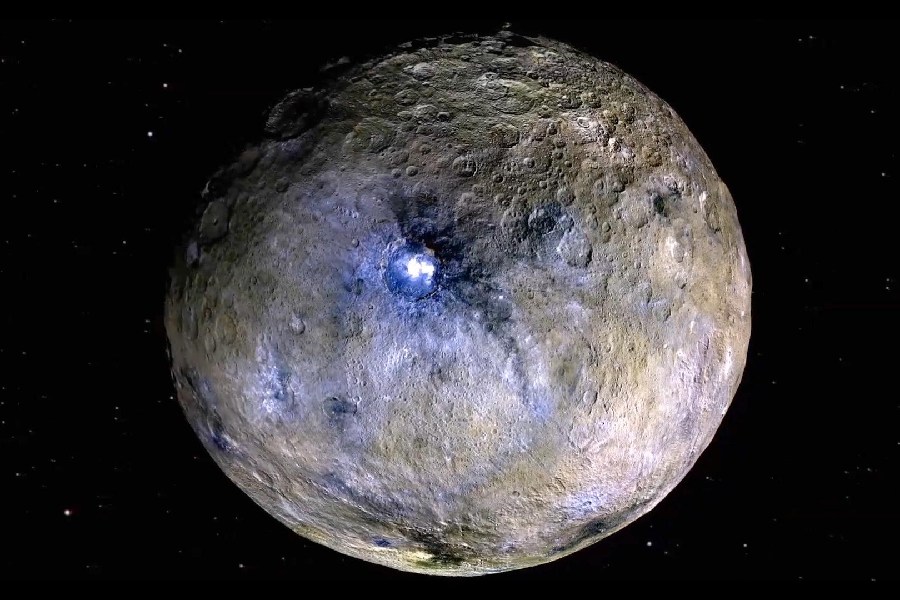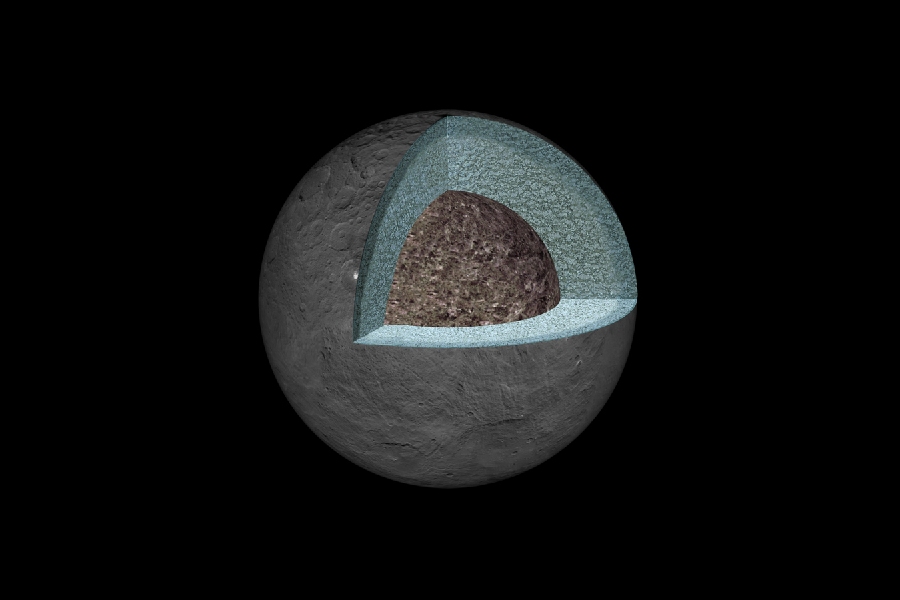Hidden within the Asteroid Belt, a celestial enigma beckons – Ceres, the largest resident of this rocky realm. The first to be classified as a dwarf planet, the true composition of this mysterious world has long eluded us. As telescopes gaze toward Ceres, one burning question arises: What is Ceres made of?
In this article, we’ll explore the latest findings and scientific hypotheses surrounding this question. As a unique celestial body orbiting the Sun, unraveling Ceres’ composition could provide valuable insights into the formation and evolution of our Solar System.
Its composition holds clues about the materials and processes of planetary formation billions of years ago. Through this exploration, we’ll dive into the observations and analyses conducted by spacecraft missions and scientific studies focused on Ceres.
Join us as we piece together the evidence to solve this cosmic puzzle!

What Is Ceres Made Of?
Ceres is composed primarily of rock and ice. Scientists believe it has a rocky core enveloped by a thick layer of water ice mixed with other minerals.
This icy composition sets it apart from most other asteroids. Additionally, Ceres boasts a thin atmosphere of water vapor. Its unique combination of rocky and icy materials makes Ceres an intriguing object of study.
Ceres’ Core
Ceres’ core is of particular interest due to its potential implications for understanding the formation and evolution of not just Ceres itself but also the entire Asteroid Belt and possibly even the early Solar System. Scientists hope to gain insights into the processes that shaped Ceres and its surrounding environment billions of years ago by studying the core.
Investigations into Ceres’ core involve a combination of data from spacecraft missions, such as NASA’s Dawn mission, as well as theoretical modeling and analysis. These efforts aimed to decipher the core’s size, composition, and dynamics, which revealed crucial information about Ceres’ geological history, internal structure, and potential for hosting environments conducive to life.
Rocky core
Ceres likely has a rocky core composed primarily of silicate rocks like olivine and pyroxene, potentially containing metallic iron and nickel as well. With an estimated 180-210 km (111.8-130.5 mi) radius, this dense core points to early differentiation that separates denser materials inward.
Studying Ceres’ core composition sheds light on the dwarf planet’s formation conditions like temperatures and pressures during its accretion phase billions of years ago. The distinct core provides valuable insights into Ceres’ origins and evolution within the Asteroid Belt.
Solid core
Ceres is believed to have a solid, rocky core at its center, lacking any molten or liquid components. This suggests Ceres did not experience intense enough heating for its core to melt during formation.
The solid core likely consists of dense silicate minerals like olivine and pyroxene, as well as metallic iron and nickel that sank inwards. Ceres’ solid, high-density core makes up a significant portion of the dwarf planet’s mass and interior structure.
Surface of Ceres
Various intriguing features characterize Ceres’ surface, including impact craters, mountains, and unique bright spots. Studying these features provides insights into the dwarf planet’s geology and history.
The surface of Ceres is thought to be composed of water, ice, and minerals, with clay minerals, carbonates, and salts having been detected. Understanding the surface composition is important for determining Ceres’ origin and evolution.
Occator Crater
Occator Crater is a large impact crater located near Ceres’ equator, with a diameter of around 92 km (57 mi). This crater is one of the most prominent features on Ceres’ surface.
Within Occator Crater, there are several exceptionally bright spots or regions. These spots reflect sunlight much more strongly than the surrounding terrain. The brightest spots are located in the crater’s center.
The bright spots in Occator Crater are intriguing because they may be composed of salts or other minerals left behind by cryovolcanic activity. Studying their composition helps scientists understand the geology and potential internal activity on Ceres.
Cerealia Facula
Cerealia Facula is another prominent bright area on Ceres’ surface, located in the northern hemisphere of the dwarf planet. This feature is thought to be a dome or cryovolcanic structure. The bright material in Cerealia Facula may have been deposited through cryovolcanic eruptions.
This suggests that Ceres could have had internal heat sources driving this activity. Understanding cryovolcanism on Ceres provides insights into the dwarf planet’s internal structure and evolution.
Impact crater features
Ceres’ surface is heavily cratered due to impacts from asteroids and comets. The craters range in size from small bowl-shaped ones to larger complex craters. Studying these impact craters helps determine the age of Ceres’ surface.
The craters’ shape, size, and distribution provide information about surface processes. Fresh craters have sharper rims and ejecta blankets around them. Older craters appear more degraded and eroded over time.
Additionally, some craters on Ceres exhibit bright rays or streaks extending outward, formed by ejected material during the impact event. Analyzing these crater rays reveals details about the surface composition of Ceres.

Interior of Ceres
After studying Ceres’ surface, focus shifts to its interior composition and structure – key to understanding its origins and formation. Interior knowledge guides theories about planetary processes across the Solar System.
Internal structure model
Scientists have developed models to explain Ceres’ internal structure based on data from various observations and measurements. The most widely accepted model proposes that Ceres has a layered internal structure with distinct zones or layers.
It is theorized that Ceres has a dense, rocky core surrounded by a thicker mantle layer of a different composition. The mantle layer is thought to be primarily composed of water ice. It may also contain other materials like silicates and salts.
The exact proportions of these materials are still being investigated. Above this ice-rich mantle lies a relatively thin outer crust layer, which is likely a mix of ice, rock, and various minerals. The composition of this layer is linked to the different surface features seen on Ceres.
Heat sources and internal activity
Ceres, being a relatively small celestial body, has limited internal heat sources. Some warmth may come from leftover heat from its formation and radioactive decay.
Yet, scientists are not entirely sure how much heat is generated inside Ceres and how it affects the dwarf planet’s development. Still, Ceres boasts intriguing features, like its bright spots and possible cryovolcanic domes.
These hints at the potential for internal activity fueled by heat from its inner layers. Understanding these processes is vital for getting a complete picture of Ceres’ billions-of-years-long evolution.
Challenges in interior exploration
Understanding Ceres’ inner composition and structure is tough for scientists due to limited ways to explore it directly. They mostly use remote sensing data from spacecraft flybys and study Ceres’ gravitational field.
In the future, missions with better tools might provide more clues. Still, figuring out what’s inside Ceres remains a big puzzle that keeps researchers interested.
Hydrated Minerals and Ingredients For Life
NASA’s Dawn mission uncovered hydrated minerals on Ceres, hinting at the dwarf planet’s potential habitability. These minerals, formed by interactions with water, suggest past internal heating on Ceres.
It’s crucial to understand the presence and spread of these minerals, including ammonia-bearing clays, carbonates, and salts. This knowledge sheds light on Ceres’ internal makeup and helps assess the possibility of life-supporting ingredients existing there.
The presence of hydrated minerals on Ceres suggests the tantalizing possibility of water, carbon, and other life-building elements being present. This discovery opens up exciting avenues for further exploration and investigation into the potential habitability of Ceres.
Organic materials and ice mantle
Data from the Dawn spacecraft suggests the presence of organic materials on Ceres. These compounds, essential for life, are carbon-based and are found on the surface.
Ceres’ internal structure is believed to include a thick ice mantle surrounding a rocky core. This ice mantle could potentially contain organic materials, creating a possible habitat for life under the right conditions.
Additionally, bright spots and dome-shaped features are observed on Ceres. These could be signs of cryovolcanic activity, bringing materials from the planet’s interior, potentially including organic compounds, to the surface. Understanding cryovolcanism on Ceres is crucial for assessing the availability of potential life ingredients within this world.
Moreover, future exploration missions with advanced instruments might aim to make significant discoveries. Directly sampling Ceres’ surface and subsurface regions is a key goal for astrobiologists searching for signs of life or its precursor ingredients.
Conclusion
Unraveling the composition of Ceres, the largest resident of the asteroid belt, has been a cosmic riddle that astronomers have long sought to solve. So, what is Ceres made of?
We provided insights into the dwarf planet’s rocky core, composed of silicate rocks and metallic components like iron and nickel. The existence of this distinct, dense core is evidence that Ceres underwent an early process of differentiation, separating denser materials inward.
Scientists continue probing this enigmatic world. Unlocking the secrets of its internal makeup will shed light on Ceres’ origins as well as the very building blocks and formative pathways that shaped our Solar System’s primordial years.
